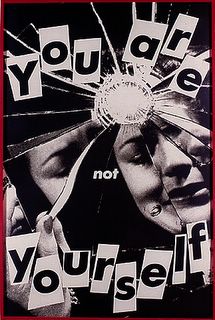1- Clouds mean rain, a falling barometer means that a storm is coming, a twister in the sky means an approaching tornado: one is a sign of the other.
These relations exist in nature and were discovered, not invented by humans. On the other hand, a bell ringing means the end of class, the word “cat” means a certain species of domesticated quadruped. These relations are
conventional. 2- In art, what is it that makes a thing a
symbol? It is something represented in the artwork (an object, an action, or a pattern of objects and actions, or just a color) that does the symbolizing? How does A become a symbol of B? 3- The cross is a symbol of Christianity (a conventional token of suffering) but this is a historic and religious convention. Though used as the main symbol of nazism, the
swastika is considered sacred in
Hinduism,
Buddhism and
Jainism. Who owns the symbol? The sun seems like a natural symbol of life and strength; a river brings forth the idea of eternal change and flowing, and so forth. In these cases there was no agreement (convention) as to what would stand for what; the relation is too obvious. 4- According to philosopher
Nelson Goodman one can virtually make any A to stand for any B, provided one can justify the link -an important premise for an artist. 5- Here are some examples of how virtually anything can be a symbol for something else: animals, parts of the body, abstract characters, artefacts, plants, etc. A circle → the cosmos (in
Shamanism); a triangle→ perfection; an ant→ industry; the ape → loyalty and devotion (ancient India); the arch→ the union of earth and sky (ancient Greece); the human beard→ wisdom, strength and virility (Semitic religions); blood→ a tantric image of fertilization (Vedas); ying/yang→ positive, negative (Ancient China); A and ω→ beginning and end (ancient Greece); the dog→ watchful guardian (ancient Egypt);
Moby Dick→evil. 6- So, to further problematize the issue: What would Duchamp's
Fountain stand for?











